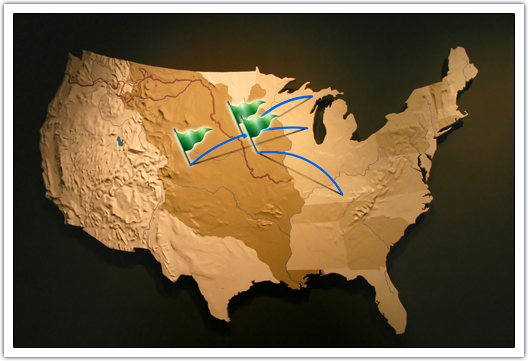The arrival of the horse, coupled with westward colonizing pressure from Europeans, pushed many tribal peoples out of the forests of Minnesota and Wisconsin onto the Great Plains where they thrived for a century as nomadic hunters.

Most of the Great Plains and northern
prairie lands would not be seen by Europeans until the second half
of this century. Anglo-European pioneers were not the first
people to colonize the Great Plains in the 'historical
period.' That distinction goes to the Indians themselves, who
moved out of the eastern forests onto the plains in two great
waves. The first, in the early 1700s, was a voluntary exodus;
the second, extending over a thirty year period, 1816-45, was a
forced march.
The first wave - made up of thirty
tribes - included Sioux and Cheyenne farmers from the upper
Mississippi Valley, Blackfeet agrarians from the north of the
Yellowstone, and Comanche and Kiowa hunter-gatherers from the Rocky
Mountains. They were joined by woodland Osages, Poncas, Otos,
Missouri, and other Siouian speaking people. New homelands
extended from the heartland of modern day Canada, to the Rio Grande
Valley, in Texas. This also was the principal habitat for the
American bison, which ranged freely across a million square miles
of grasslands in herds that numbered in the millions.
What made the Indian migration
possible was the arrival of the horse, which first appeared in the
southwest in the 16th century following the Spanish expeditions of
discovery. The horse was the grand catalyst that
revolutionized native cultures and soon became their means of
support and the center of their economy
Related People
Related Events
Related Flashpoints